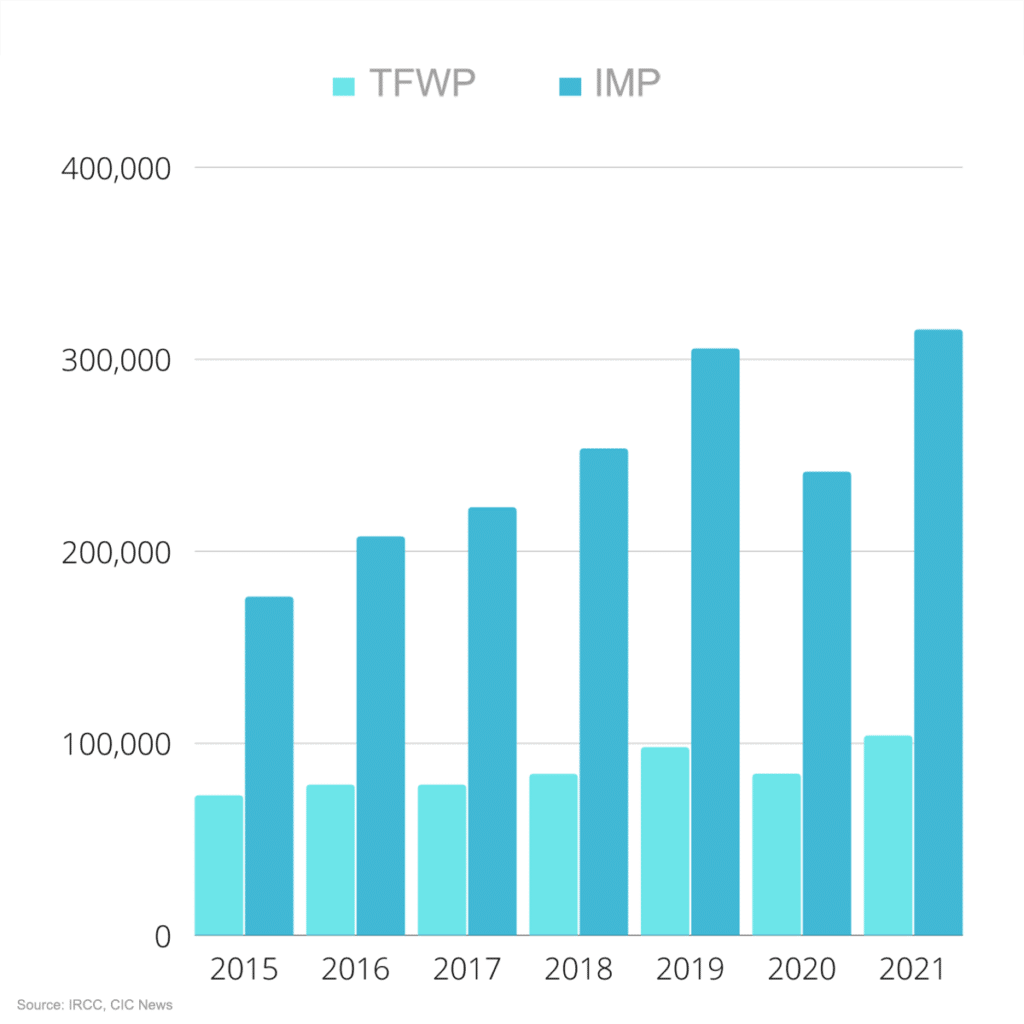Why more Canadian employers are hiring foreign workers
Canadian employers hire hundreds of thousands of international workers every year through more than 100 different work permit pathways. With the exception of 2020, these numbers have only been going up since 2015 and there are no signs of stopping.
Canada is facing a high number of job vacancies and a relatively low unemployment rate, which means there are more jobs open than there are qualified workers to fill them. According to Statistics Canada, for every 100 positions in December, employers were seeking to fill an average of 5.2 vacancies, up from 3 in the fourth quarter of 2019. This increase in vacancies happened alongside the fall of Canada's unemployment rate, which was 5.4% in December 2021, the lowest since December 2019 when it was 5.2%.
All this to say, there are sectors with high numbers of job vacancies and not enough workers in Canada to fill them. Recruiting foreign talent is one way Canadian employers can fill vacant positions in their company.
Schedule a Free Work Permit Consultation with the Cohen Immigration Law Firm
Foreign workers need a work permit in order to work legally in Canada. In some cases, the employer has to do what is called a Labour Market Impact Assessment (LMIA), or a labour market test, in order to hire a foreign worker. Although, the majority of work permits issued in a given year are LMIA-exempt.
In this article, we will talk about the difference between the two biggest categories of work permit programs, and how employers can use them to hire international talent.
LMIA and LMIA-exempt work permits
There are two major work permit programs: the Temporary Foreign Worker Program (TFWP), and the International Mobility Program (IMP).
The major difference between the two is that the TFWP requires employers to get an LMIA, whereas IMP work permits are LMIA-exempt.
The TFWP is meant to address labour shortages in Canada. Employers must complete the LMIA process to demonstrate to Employment and Social Development Canada (ESDC) that the hiring of a foreign worker is due to the absence of suitable workers. ESDC assesses the LMIA to confirm that hiring a foreign worker will have no negative impact on the Canadian labour market. Once the employer receives the positive or neutral LMIA, they provide a copy to the foreign worker so they can submit it along with their work permit application to Immigration, Refugees and Citizenship Canada (IRCC). The employee can then start working once their work permit application is approved.
By contrast, the IMP exists to support Canada’s broad social, cultural and economic objectives, so there is no need for a labour market test. There are many IMP work permits that are a result of Canada’s free trade agreements. For instance, the Canada-United States-Mexico Agreement (CUSMA, formerly known as NAFTA) is a prominent free trade agreement that allows U.S. and Mexican citizens to work in Canada without an LMIA. Youth from around the world are able to work in Canada under the IMP due to youth mobility agreements between Canada and certain other nations.
Canada also allows international student graduates and eligible spouses and common-law partners to get open work permits under the IMP. Open work permits allow workers to accept any job offer in Canada regardless of employer or occupation. All open work permits fall under the IMP, so employers do not need an LMIA to hire these workers.
Canadian work permits issued by year 2015-2021

How do I hire a foreign worker under the TFWP?
The first step is to complete the LMIA requirements for the work permit that you wish to apply for. There are a number of specialized application processes, some of them have a facilitated LMIA process. The Global Talent Stream is one example of a work permit program that allows employers to skip the advertising requirement, and allows eligible tech workers to get their documents processed in as little as two weeks.
The LMIA application process also depends on what type of program you are hiring through. They are broken into four categories:
Once you get the LMIA, then you can give a copy to your foreign employee to apply to IRCC. They will also need to submit a contract and a job offer letter, which should include information about their pay and deductions from pay, their job duties, and conditions of their employment such as hours of work.
If the worker is approved, they will receive a letter of introduction. They can then get their work permit from a border services officer when they arrive in Canada. If they are already in Canada, IRCC will mail them the work permit.
How do I hire a foreign worker under the IMP?
Employers can check the LMIA exemption codes and work permit exemption codes for the list of situations where hiring a foreign worker does not require an LMIA.
Some of the common IMP work permit programs include:
- CUSMA: Citizens of the U.S. and Mexico may be eligible for facilitated processing when applying to work in Canada.
- Intra-Company Transfers: Allows employers to transfer certain workers to their offices in Canada.
- Television and Film: Canada welcomes entertainment industry workers to support its booming TV and film industry.
- Business Visitors: Foreign workers who will be in Canada for less than six months and who will not be entering the labour market, can be eligible to work in Canada without needing a work permit.
- International Experience Canada: Canada has bilateral agreements with more than 30 countries that allow international youth to gain work experience in Canada.
- Bridging Open Work Permit: Eligible skilled worker candidates living in Canada can apply for a BOWP while their permanent residence application is being processed. Eligible spouses and common law partners of Canadian citizens and permanent residents can get a BOWP if they are living in Canada.
- Post-Graduation Work Permit: The PGWP is the most common work permit under the IMP. Eligible international graduates of Canadian designated learning institutions (e.g., colleges and universities) can get this open work permit for up to three years.
In order to hire through the IMP, employers need to pay an employer compliance fee and submit an offer of employment form through IRCC's Employer Portal. This must be done before the foreign worker can apply for a work permit.
Schedule a Free Work Permit Consultation with the Cohen Immigration Law Firm
© CIC News All Rights Reserved. Visit CanadaVisa.com to discover your Canadian immigration options.
- Do you need Canadian immigration assistance? Contact the Contact Cohen Immigration Law firm by completing our form
- Send us your feedback or your non-legal assistance questions by emailing us at media@canadavisa.com







